
Evan Anderson (Zola Windows’ VP of Operations) and I just had the pleasure of attending the Passive House Northwest (PHnw) conference in Portland on February 28 and March 1. Zola was proud to sponsor the event and happy to see the highest-ever attendance of a PHnw conference: nearly 250 attendees. Maybe it should come as no surprise to see this sort of turn out given that this was PHnw 10th annual conference. In any case, it was heartening to sense a growing momentum in the region’s Passive House community, both from a vendor perspective (Zola has been providing high performance windows to the Northwest’s Passive House community almost from the inception of PHnw) and from a concerned citizen’s perspective (we have no time to lose to transform buildings from “climate problem” to “climate solution”).
I’m now in my third year of PHnw board service, and in that capacity was invited to deliver a keynote address at the conference sharing a vision for what the next ten years will hold for PHnw and the Passive House community. Here are a few highlights from that talk.
It’s safe to say that the next ten years will be a big decade for the high performance building industry and for the planet. Last October, the IPCC (Intergovernmental Panel on Climate Change) released a sobering report, “Global Warming of 1.5°C,” finding that, at our current rate of carbon emissions, we have just 12 years left in our “carbon budget” before we exceed 1.5°C warming. The report also lays out a litany of impacts anticipated from 1.5°C warming (bad) and 2°C warming (worse). One headline-grabbing stat: at 2°C warming, 99% of coral reefs will die. Dire stuff.
Still, the report affirmed that it is still possible to limit warming to 1.5°C, though conceded that “there is no documented historic precedent” for the scale of change necessary to hit that target. The report was a carefully crafted piece of climate communication, with every word scrutinized for its precision and impact. The takeaway quote:
“Limiting temperature requires unprecedented changes in society, but will have huge benefits. Every half a degree of warming matters.”
IPCC
That word, “unprecedented,” is really the centerpiece of the report. We are past the time when incremental change will cut it. We need exponential change, a step jump. Spoiler alert: that’s what Passive House does for buildings.
This idea of exponential progress in climate action has been a focus of Christiana Figueres (of Paris climate talk fame) and other leaders who published the “Exponential Climate Action Roadmap” to coincide with the Global Climate Action Summit in San Francisco last summer. According to Figueres:
“Disruption is here. Three unstoppable forces are pushing us towards a future of prosperity, growth, and clean energy: climate leadership, market forces, and the digital revolution. This roadmap provides an insight into how these will combine to create the future we all want.”
CHRISTIANA FIGUERES
As the roadmap states, to limit warming to well below 2°C, the world must follow the “carbon law”: ensure that emissions peak by 2020; cut them in half by 2030; cut them in half again by 2040, and again by 2050, and so on.
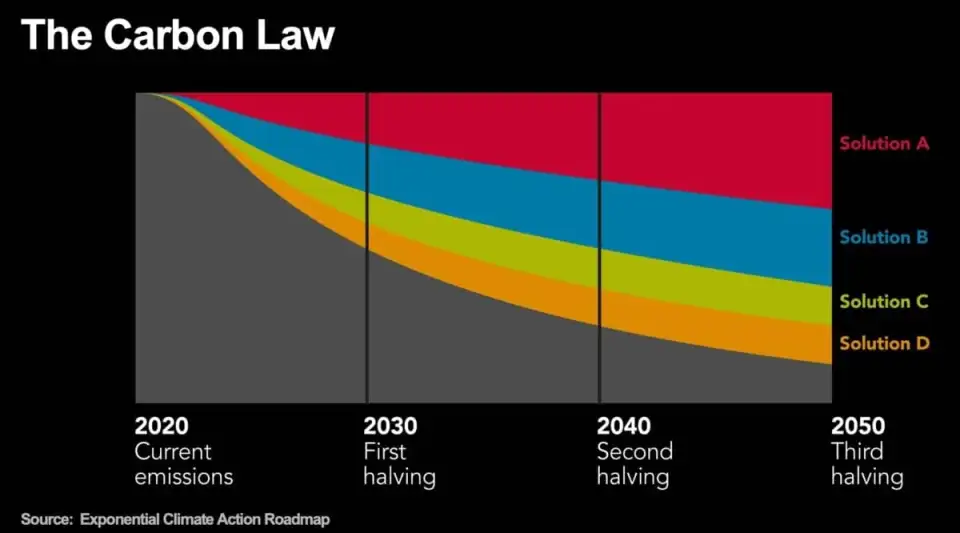
The roadmap then lays out how this can be achieved, sector by sector, with special attention paid to the first decade. Here’s what that first halving of emissions looks like in the building sector:
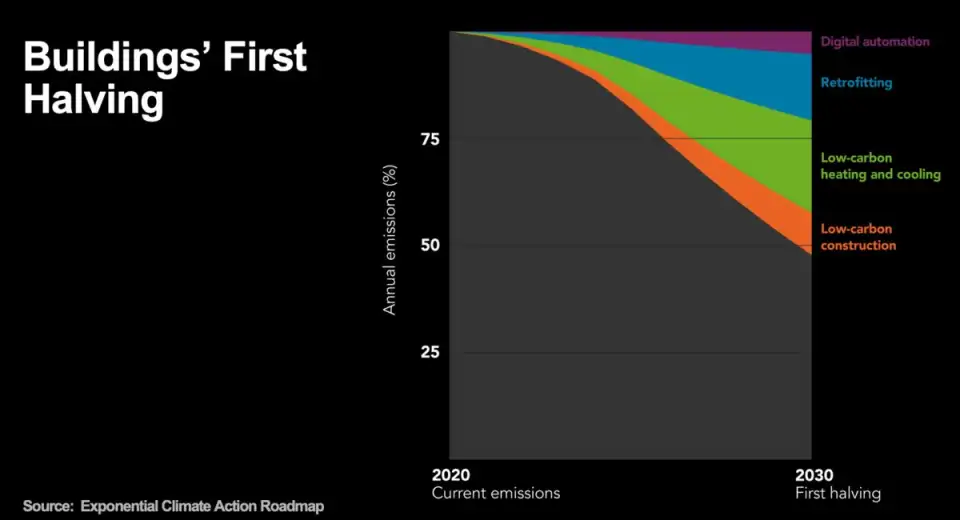
A slice of emissions reduction comes from digital automation, things like smart thermostats and demand response enabled by the IoT (Internet of Things). A big chunk of emissions reduction comes from retrofitting existing buildings (which, ahem, calls for really good windows). The biggest reduction comes from low-carbon heating and cooling, which Passive House excels at by reducing heating and cooling loads by as much as 90%. (That, ladies and gentlemen, is what a step jump looks like, btw.) The rest of the halving is achieved by reducing the embodied carbon of the materials and process of construction.
Voilà!
But before you write this off as magical thinking, consider the power of innovation to drive exponential change in the marketplace, particularly in the ongoing clean energy transition. Clean energy is technology, not fuel. In technology, innovation drives cost down. We see this with Moore’s Law in the microchip industry, which observes that every couple of years the number of transistors that will fit on a chip doubles. This has driven exponential growth in computing power (behold the smartphone supercomputer in your pocket) and the equally rapid decrease in the cost of that power.
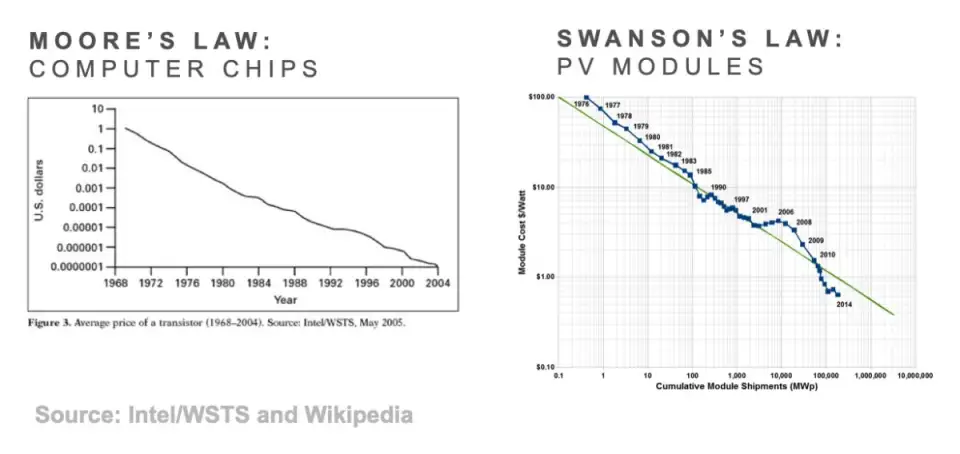
In the clean energy space we have a similar law, variously called Swanson’s Law, the learning curve law, or the experience curve. In solar energy, Swanson’s Law says that every time we double the amount of solar energy deployed around the world, the learning that comes with that deployment will drive the cost of solar energy down by 22% to 24%. This is what that looks like:
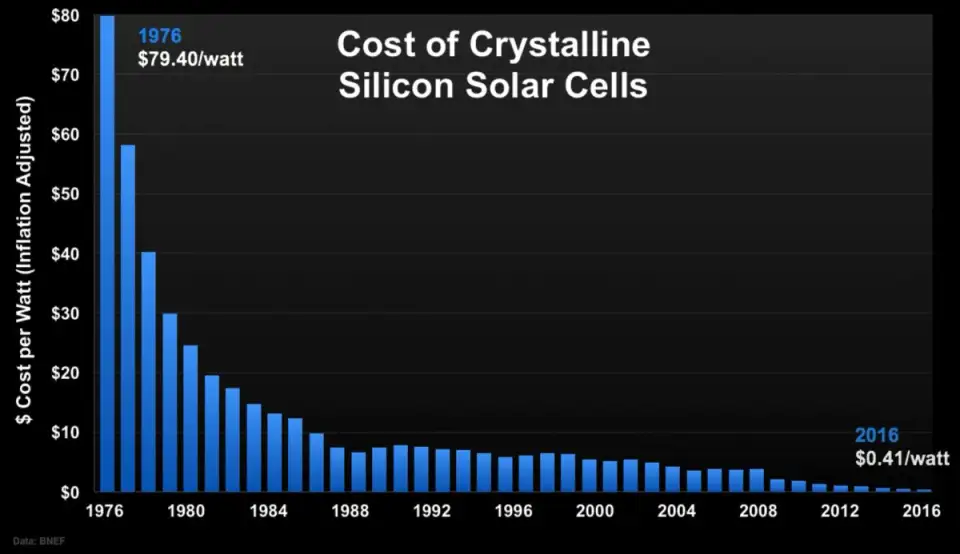
That’s a cost decline of 99.5% between 1975 and 2016. We see similar downward cost curves across the clean energy space:
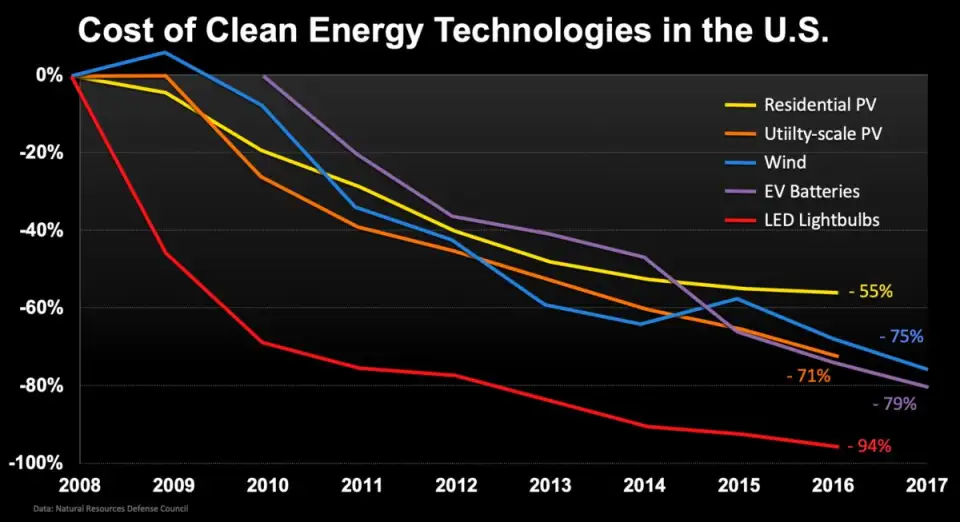
These clean energy prices are “unprecedented” and are driving exponential uptake of clean energy:

These same dynamics are at work for us in the Passive House industry. As we design and build more Passive House buildings, we get better at it and costs fall. With more volume of Passive House projects under construction, manufacturers (Zola among them) respond with their own innovations and deliver better components at lower prices. As overall costs fall, demand for Passive House rises, and you have the kind of virtuous, self-reinforcing cycle in place to drive exponential change. Here’s what is happening with PHIUS+ certified Passive House construction in North America, for example:
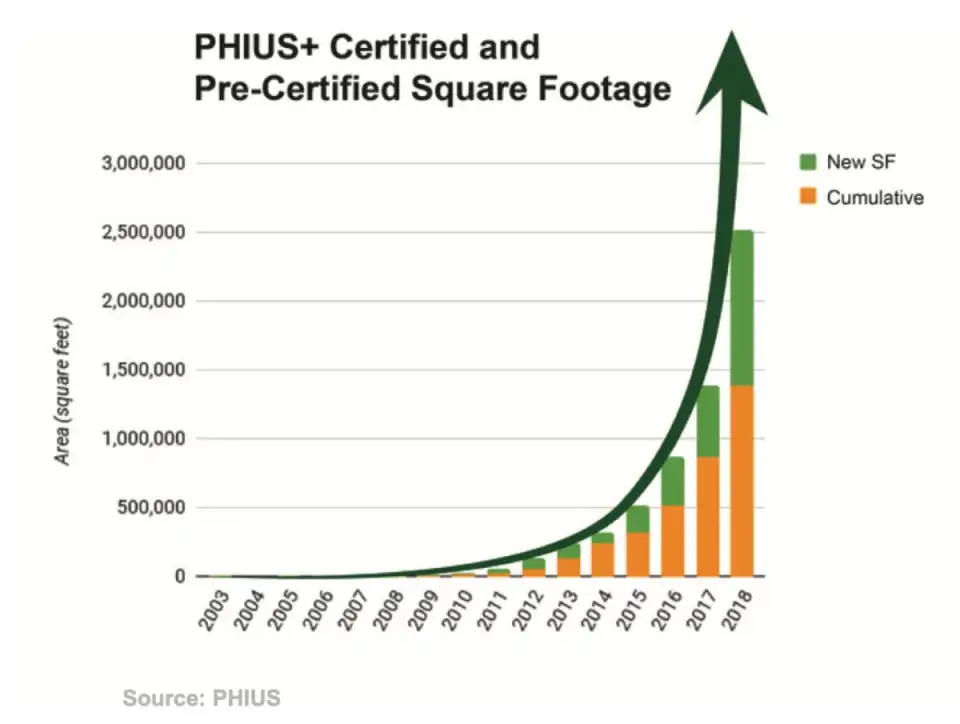
None of this comes a moment too soon, and needs to accelerate. Given the urgency of the climate crisis and the outsized role that buildings play in it (responsible for almost half of US greenhouse gas emissions, according to Architecture 2030), it’s clear that we need two things from our buildings today:
Ambition: energy performance and emissions reductions at a level that matches the urgency of the climate crisis; and
Scale: delivery of these emissions reductions so cost-effectively that it will scale up in the marketplace and provide equitable access to climate-wise buildings.
That is the promise of Passive House: ambition at scale.
The reason it brings this potential power? The insight that the building itself, its skeleton and skin, is technology. So, innovation can drive cost down and performance up. When we think of technology in buildings we usually think of all the mechanical equipment that we stuff into conventional buildings to make up for how poorly the building envelope performs, as shown in this now-famous illustration by Albert, Righter & Tittman Architects:
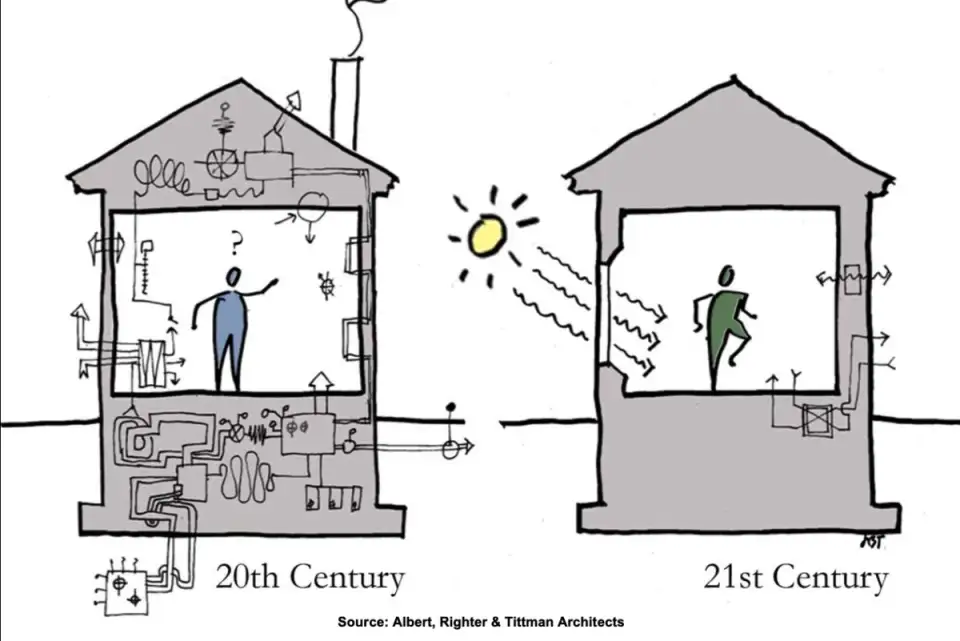
But by designing a robust building envelope (with great windows and doors), eliminating thermal bridges, and optimizing passive design, the Passive House approach simplifies systems and revolutionizes performance. There’s actually a direct analog to this elsewhere in the clean energy transition: electric vehicles.
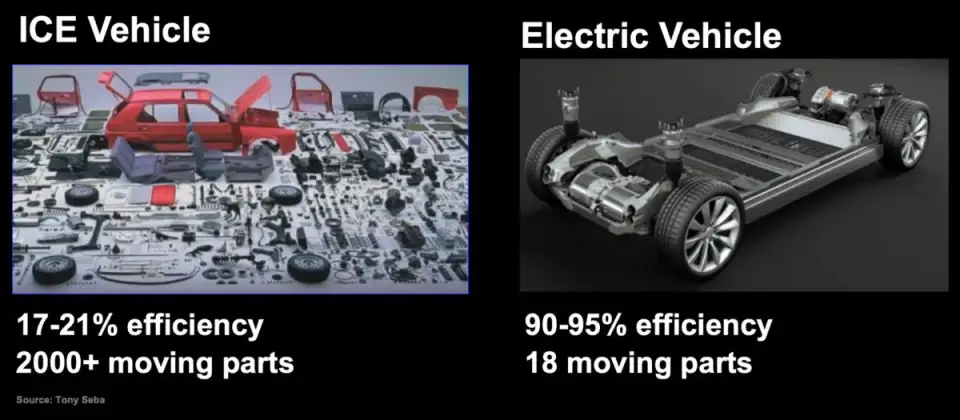
The internal combustion engine is both incredibly complex (over 2,000 moving parts) and incredibly inefficient (17–21% efficiency at turning the energy embodied in gasoline into forward movement). Electric vehicles, on the other hand, are astonishingly simple (only 18 moving parts) and efficient (90–95% efficiency in turning the energy stored in batteries into forward movement). Thanks to Swanson’s Law in batteries and EV production, the upfront cost of EVs will be lower than that of ICE vehicles in just a few years. Sometime in the early 2020s, the hipper, cleaner, faster, and cheaper to operate and maintain technology will be cheaper to purchase than its fossil-dependent predecessor. They say that in technology, winner takes all. What sort of transformation can we expect in transportation in the next 10 years? A pretty exponential one. “Unprecedented.”
Well, we need to see the same in the building sector, and the pace of change has to quicken. The good news is that more jurisdictions are seeing the need to catalyze Passive House-style change in our buildings. New York City is pursuing building policies that align with the Carbon Law mentioned above and that harness Passive House as a solution. Here in the Pacific Northwest, Vancouver, BC is ahead of everyone, with dozens of major passive House projects underway, spurred on by city policy that makes Passive House the path of least resistance to profitable development there. Meanwhile, the Washington State legislature passed a resolution a few years ago that requires Passive House-levels of energy performance in new buildings by 2031, without actually naming Passive House specifically. Oregon Governor Kate Brown set a similar course for Oregon with her recent executive order on net zero buildings.
So our region is setting ambitious goals for buildings and needs to know how to reach those goals cost-effectively. We in the Passive House community have the answer. We don’t have the only answer, of course. It’s important to have the humility to acknowledge that there are other pathways to ultra energy efficient buildings. But we have shown time and again that we can deliver “unprecedented” energy efficiency in buildings in a way that makes economic sense.
Finally, we can dramatically reduce the operational carbon emissions of our buildings while also reducing the embodied carbon emission from construction materials and construction processes. In fact, we might even be able to sequester carbon in our buildings. For an excellent primer on this subject, read Bruce King’s “The New Carbon Architecture”:
I have to admit to initially being skeptical about embodied carbon. I knew it existed, but compared to the operational carbon emissions over the 90-year life span of a building, it seemed unimportant. See this from Bruce King’s book:
But in 2019, we do not have 90 years to bring emissions to zero. We need to do this by around 2050, more like 30 years from now. People are calling this the “time value of emissions,” and you can see that embodied carbon is suddenly really important on a 30-year horizon:
If we are serious about decarbonization, we have to tackle both operational and embodied carbon in our buildings. Over half of embodied carbon is contained in the structure and envelope of buildings today. So if we can switch form high emitting materials like concrete, steel, and many forms of foam insulation, we can make a real difference. Can we actually sequester carbon through use of sustainably harvested timber and wood fiber products? This chart developed by Arup shows the potential:
Contrast that with concrete and you can see what a difference this could make in our buildings:
That said, if the wood is harvested unsustainably and the wood products are transported a long distance, the end result is almost as bad as using concrete, according to Arup analysis:
One of the hurdles to low embodied carbon design has been the lack of good, transparent data on the embodied carbon implications of various materials and components. That’s about to change, thanks to an open-source and free tool being developed by Skanska, Embodied Carbon Forum, Interface, and C‑Change Labs: the Embodied Carbon Calculator for Construction, or EC3. Stay tuned for its November 2019 launch.
The next ten years will likely be the most important in most of our careers. And while it is a time of climate peril, it is also a time of unprecedented opportunity to transform how we design and build. Buildings have become a form of climate action that can unlock tremendous economic potential. (See this recent article about Passive House in Vancouver, “New green building standards could create $3.3B in Metro Vancouver market demand: report.”) As I first heard from Al Gore, we are living through a sustainability revolution that has the scope and import of the industrial revolution but carries the speed of the digital revolution.
Let’s accelerate this revolution, together.